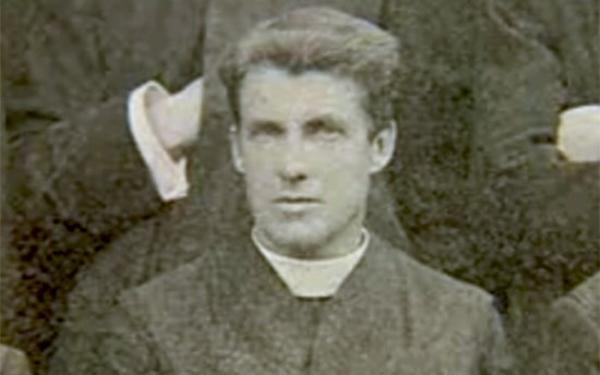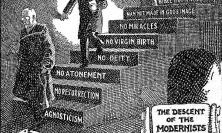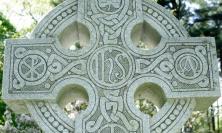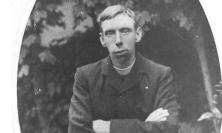15 July 2009 is the 100th anniversary of the death of George Tyrrell SJ. Tyrrell was born into a Protestant family in Dublin in 1861 but later became a Catholic and then a Jesuit – a description that also applies exactly to the life of another Irish Jesuit, John Sullivan. Michael Hurley SJ contrasts the lives of these two men, who, despite their similarities, lived and are remembered very differently.
George Tyrrell and John Sullivan were contemporaries, born in the same year and in the same Irish city, into the same social class, with the same political and religious affiliations: Unionist and Protestant. Eventually they both became Catholics and, to boot, joined the Jesuits, an intriguing coincidence, especially as their lives ended very differently. George, who died a century ago, on 15 July 1909, was denied a Catholic burial; John, who lived until 1933, died in the so-called ‘odour of sanctity’. What follows is an attempt at comparing and contrasting their lives.
George Tyrrell was born on 6 February 1861 at 91 Dorset St, Dublin, and John Sullivan on 8 May that year, also in Dublin, at 41 Eccles St. Both were born on what was at that time the socially correct side of the city, north of the river Liffey, and very shortly afterwards both families moved with the times, crossing the city to live on the south side of the river. Dublin was then, after the Act of Union in 1801, the political capital in Ireland of the United Kingdom of Great Britain and Ireland. John’s father was a barrister with a County Cork background who later became Lord Chancellor and as such, it was said, ‘the real governor of Ireland’. George’s father was a journalist: sub-editor of the Dublin Evening Mail, ‘then a well-known organ of Protestant Toryism’, andDublin correspondentof The Times. He died a few weeks before George was born. Both fathers were members of the Church of Ireland, which was ‘Protestant’ and ‘Episcopal’ – Anglican in modern parlance – and independent of the Church of England since disestablishment in 1869. John’s mother, however, was a Catholic.
The Tyrrells were certainly poor and not just by contrast with the Sullivans .The latter settled on the south side of the Liffey in the recently built Fitzwilliam Place, with a summer house in Killiney, and John spent six happy years boarding at Portora Royal School near Enniskillen. The Tyrrells on the other hand lived a somewhat unsettled, itinerant existence. Now fatherless, they lived successively with relatives or in lodgings in Portarlington, Bray, Rathmines, and finally back on Dublin’s north side at 4 Eccles Street where their Catholic landlady, Miss Lynch, became an influential friend of George’s. Dr Benson’s Rathmines School gave George a free place, and later in life he would sometimes put ORS (Old Rathmines Schoolboy) as well as SJ after his name. Here, from 1873 to 1878, he received a rich general education but idled away his time – he failed a sizarship examination for Trinity College Dublin (TCD) and went to live in London in 1879. That same year, John Sullivan, having finished at Portora, entered TCD where one of his professors was George’s cousin, the distinguished Robert Yelverton Tyrrell, well known as the editor of Cicero’s letters.
Why and how did John and George become Catholics and Jesuits? George had been precociously religious while in Rathmines and, within a few months of arriving in London, he was received into the Catholic Church at Farm Street and the following year entered the English Jesuit noviceship at Manresa House. In contrast, it was seventeen years from the time John left Portora until his reception into the Church at Farm Street, and another four before he entered the Irish Jesuit noviceship at Tullabeg, which he did in 1900.
John’s s mother was, unusually for the time, a daily communicant but the culture of the family’s social milieu was definitely, if moderately, Protestant Unionist. His father’s position, while he lived, would also have been a restraining influence. The times were troubled by agitation for land reform and for Home Rule, and Sir Edward was a strict if not severe law and order man and no friend of Gladstone’s Home Rule policies. Upon his father’s sudden death in 1885, John left TCD, went to London and in due course was called to the English Bar. For the next decade or so he lived partly in London, partly in Dublin, and his way of life was what spiritual writers call ‘worldly’.
John Sullivan was noted for his devotion to Augustine and Monica and this has suggested to some that he may have sown his wild oats at this time. Unlike George Tyrrell he was a conventional Protestant Anglican and, while in TCD, ceased to practice. He was certainly a worldling, but ‘not a lady’s man’, as one of his young female friends put it. Rather, he was a good-looking, fashionable bachelor, ‘the best-dressed young man in Dublin’ who had ‘beautiful blue eyes’ and carried ‘a dandy stick’ – a black walking stick with a silver knob. He particularly enjoyed walking holidays alone on the continent, especially in Greece with which he had fallen in love when, while in TCD, he had gone on one of the regular tours organised by the noted Hellenist, Professor Mahaffy.
But somehow during this period, John Sullivan became more religious. One of the ‘skips’, his Catholic bed-maker at TCD, had once invited him to go to Mass and he seems to have gone with her at least that once. While on holiday in a Kerry hotel he overheard a governess giving a Catholic catechism class to a child and he asked to share in it. However, the major religious influence on John Sullivan seems to have been Mount Athos, an independent republic of Orthodox monasteries in the north of Greece. Sullivan presumably went to visit but stayed for several months. At least now, female visitors are excluded and non-Orthodox visitors are limited in their participation in the monastic life and in their length of stay. It says much for John Sullivan’s personality and in particular for his developing religious instincts that he wished to prolong his stay and that he was welcomed by and formed friendships with some of the monks.
By contrast, one, if not the major influence on George Tyrrell’s religious development was his introduction by a school friend to the Catholic Anglicanism, the Tractarianism, of All Saints’ Church, Grangegorman, on the north side of Dublin, where the formidable W.B.Maturin was then Vicar. His visits were to some extent adolescent venturesomeness on his part as he was still in his early teens. ‘The birettas and cassocks made the fibres of one’s Protestantism quiver. I had almost discovered a new sin, and found the sensation novel and agreeable.’ But the early death of his brilliant, agnostic, crippled brother, Willie, and the influence of ‘this quiet, holy, unselfish little woman’, his landlady, Miss Lynch, made him more religious and more venturesome: he began to visit Catholic Churches, to read spiritual books and to say his prayers. But he also became friendly with an Anglican layman, Robert Dolling, who later was to become famous as ‘Father Dolling of the slums’. Concern for the poor was a prominent feature of Dolling’s Catholicism and he invited George to London to help him with ‘a sort of guild and semi-religious club for postmen’. George went, leaving Dublin in the year that John Sullivan arrived back from Portora. As previously mentioned, within two months of arriving in London he was received into the Catholic Church – his Autobiography makes no mention of baptism – and the following year he entered the Jesuit noviceship. News of these developments must have reached TCD where his cousin, Professor Tyrrell was as well known for his anti-Romanism as for his classical scholarship. One wonders how John Sullivan reacted to the news.
In his early years as a Catholic before entering the Jesuit noviceship, John Sullivan had abandoned his silk underwear, shaved off his moustache, thought of becoming a Capuchin Friar and became well known as a friend of the poor and sick. He was a regular visitor to the Hospice for the Dying at Harold’s Cross, to the Children’s Hospital at Cappagh, and to the Night Refuge run by the Mercy Sisters in Brickfield Lane. He was generous, bringing gifts of snuff and tea and money: he donated a gold ciborium to the Poor Clares in Carlow, and ‘on occasions [he] came to the rescue by bailing them [the poor children] out in court when, in their professional capacity as flower-girls or fish-vendors, they had got into grips with the Law’. Judge William O´Brien, a family friend with whom he often travelled when the Judge was on circuit, introduced him to many convents around the country. And during visits to his brother Sir William when the latter was resident Magistrate for Cavan, John got to know the Poor Clare Sisters in Ballyjamesduff. Greatly impressed by his devotion, the sisters seem to have advised him to join the Jesuits. So it was that on 7 September 1900 he presented himself at Tullabeg, St Stanislaus College, Tullamore – the Irish Jesuit novitiate. He was now in his fortieth year; George Tyrrell had been in his twentieth when he entered the Society. It was four years since John had become a Catholic and two years since his mother had died and he had showered armfuls of white lilies on her coffin. He treasured her crucifix all his life, held it in his hands as he gave retreat talks and blessed the sick with it. It is still treasured at Gardiner St Jesuit Church in Dublin.
Did George Tyrrell and John Sullivan ever meet? Did their paths ever cross? George never returned to Dublin after leaving in 1879; John never seems to have been in London after becoming a Jesuit. He did however live in England, studying philosophy from 1902 to 1904 at St Mary’s Hall, Stonyhurst in Lancashire. Gerard Manley Hopkins had been there a few decades before, rejoicing in the view of ‘a beautiful range of moors, dappled with light and shade’. George Tyrrell had also been there, for two periods: from 1882 to1885 as a student immediately after his noviceship, and then as a teacher after ordination from 1894 until1896, the year John Sullivan became a Catholic. Whereas John’s years of study as a Jesuit were quiet and uneventful, George’s were controversial: he became embroiled in domestic infighting when he abandoned the Suarezian, ‘anti-Dominican’ approach to Thomas Aquinas which had been traditional among Jesuits. After the intellectual laziness of his earlier years he came into his own as a thinker and writer, and he was moved to the Farm Street House of Writers in London in 1896. His remaining years as a Jesuit priest were to be far from uneventful.
However, before becoming the Catholic modernist who was to be dismissed from the Jesuits and deprived of Catholic burial, George Tyrrell had become a ‘soul-friend’ for a large number of individuals. He developed a special charism for helping people who had difficulties of faith: Protestants and Catholics, clergy as well as laity. His Nova et Vetera: Informal Meditations for Times of Spiritual Dryness was just the first of a number of spiritual books which made him highly popular. These writings and his articles in The Month and elsewhere also brought him into contact with the leading Catholic intellectual of the day, Baron Friedrich von Hügel, and eventually with most of the other prominent intellectuals in Western Europe who were making suggestions for the reform of the Church. Tyrrell’s passion for helping individual souls soon led to a passion for institutional renewal and reform of the Church, which would help souls by removing the causes of their faith difficulties. So he was shattered when, in 1907, the encyclical Pascendi condemned ‘the doctrine of the Modernists’, the suggestions for Church reform which they had been making, their attempts to address the problem of the factual truthfulness of the Gospels, and the development of dogma. ‘Audacious’ – John Sullivan’s favourite term of reprimand – to the end, Tyrrell contributed two articles to The Times critical of the encyclical; these were his downfall.
1907 was not only the year of Pascendi but also the year of John Sullivan’s ordination as a priest at Milltown Park, the Jesuit House of Theology in Dublin. In the following years he was on the staff of Clongowes Wood College, the Jesuit boarding school in Co.Kildare, and later Rector of Rathfarnham Castle, where the Jesuit students lived while attending lectures at University College, Dublin. His priesthood made him all the more compassionate towards the sick and poor. Wherever he was he sought them out, visited them and consoled them with his presence, prayers and blessings with his mother’s crucifix, and occasionally with little gifts. He now used for this pastoral work the bicycle he had used for pleasure in its early days when it superseded the ‘penny-farthing’; indeed he more than once cycled all the way from Clongowes to Dublin. His vow of poverty led him to live an austere life: shabby, patched clothes, little food and little sleep; the former worldling became as unworldly as possible. His vow of chastity made him more loving, caring and forgiving and he had a special need for these gifts of the Spirit when he was appointed Rector of Rathfarnham Castle in 1919. His years as Rector must have been a severe challenge to his Unionist background. They turned out to be the troubled times of the War of Independence and the Civil War, when Jesuit communities, like the whole country, were sharply divided in their sympathies. Rathfarnham Castle itself was raided by the notorious British Black and Tans. His vow of obedience will have helped him to accept humbly and kindly the anti-Modernist decree Lamentabili – all the more so as Pius X was also the author of a decree recommending frequent communion. Could John, by his obedience, have wished to make reparation for the disobedience of George Tyrrell?
Though denied a Catholic burial, Tyrrell was in a real sense vindicated by Vatican II. His name was indeed mentioned during the Council, but as an adversary by one of the minority: the Church, Cardinal Ruffini stated, cannot be called a ‘sacrament ’ because, for one reason, that is precisely what ‘the prince of the Modernists’, the ‘apostate priest’, George Tyrrell wanted to call it. However, when Pope John XXIII called the Second Vatican Council, he used much of the imagery and language that Tyrrell had used in a famous letter of 1908 to Cardinal Mercier. And as David Schultenover, on the last page of his critical study of Tyrrell’s thought, writes: ‘Anyone who has studied both him and the documents of Vatican II will recognise his principles reborn on nearly every page’.
By contrast, John Sullivan, generally recognised as a saint in his lifetime despite having retained in his Jesuit life something of the cold severity of his legal background – one of the ‘marked shortcomings’ acknowledged by his first biographer, Fr Fergal McGrath SJ – is still awaiting canonisation. His cause has indeed been introduced but the mills of the Vatican do grind slowly.
John Sullivan and George Tyrrell had the same Ignatian, Jesuit passion for ‘helping souls’ but they expressed it differently. It is sad that George is remembered mostly as the apostate priest, the heretical Modernist. But the words of the priest who was with him at the end: ‘You are a real old Catholic at bottom’, were only too true. Despite his many faults, his ‘Celtic’ temper in particular, George Tyrrell was a holy man, a man of prayer. There was indeed a mystical element in his spiritual life and, not at all paradoxically, he saw the saints, not the theologians, as the real teachers of the Church. He was finally tempted beyond his strength but by a Papacy which, with hindsight after the labours of Vatican II, we can now see had not, with regard to Modernism, served the contemporary Church so well.
Michael Hurley SJ is an Irish Jesuit priest and ecumenical theologian. In 1970 he founded the Irish School of Ecumenics which still continues its research and postgraduate teaching in Dublin and Belfast. In 1983 he founded in Belfast the Columbanus Community of Reconciliation, a residential, interdenominational community which continued until 2002.
References:
Mathias Bodkin, The Life of Father John Sullivan SJ (Dublin,1954)
Fergal McGrath, Father John Sullivan SJ (Longmans, 1941)
Thomas J.Morrissey, Where two traditions meet: John Sullivan SJ, 1861-1933 (Dublin, Columba 2009)
Maud Petre, Autobiography and Life of George Tyrrell (London, 1912)
Nicholas Sagovsky’s, On God’s Side: A Life of George Tyrrell (Oxford, Clarendon Press 1990)
Thinking Faith’s series on George Tyrrell SJ:
![]() George Tyrrell and Catholic Modernism – Oliver Rafferty SJ
George Tyrrell and Catholic Modernism – Oliver Rafferty SJ![]() Modernism: The Philosophical Foundations – Anthony Carroll SJ
Modernism: The Philosophical Foundations – Anthony Carroll SJ![]() Faith, Reason and the Modernists – Joe Egerton
Faith, Reason and the Modernists – Joe Egerton






